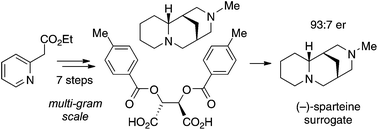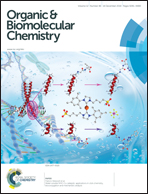Revisiting the sparteine surrogate: development of a resolution route to the (−)-sparteine surrogate†‡
Abstract
The improved performance of the sparteine surrogate compared to sparteine in a range of applications has highlighted the need to develop an approach to the (−)-sparteine surrogate, previously inaccessible in gram-quantities. A multi-gram scale, chromatography-free synthesis of the racemic sparteine surrogate and its resolution via diastereomeric salt formation with (−)-O,O′-di-p-toluoyl-L-tartaric acid is reported. Resolution on a 10.0 mmol scale gave the diastereomeric salts in 33% yield from which (−)-sparteine surrogate of 93 : 7 er was generated. This work solves a key limitation: either enantiomer of the sparteine surrogate can now be readily accessed.

- This article is part of the themed collection: In Celebration of Richard Taylor’s 65th Birthday

 Please wait while we load your content...
Please wait while we load your content...